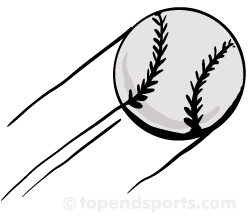The physics of baseball flight
The movement of baseballs and softballs through the air is governed by aerodynamics. As the air flows around a baseball or softball, turbulence occurs where the stitches are. The turbulence causes the air to stick to the ball just a little longer and reduces the wake (as in a boat's wake) which reduces drag. These stitches can also change the direction of the ball. A good pitcher uses the spin and the stitch alignment to throw curve balls.
 Does a pitchers arm have to move at 100mph to throw a 100mph fastball?
Does a pitchers arm have to move at 100mph to throw a 100mph fastball?
Some baseball pitchers are able to throw a fastball at a speed of over 100 miles per hour (160 km/h). In order for a ball thrown horizontally to travel at 100mph, it must have been traveling at that speed just before release too. After the release of the ball, the only forces acting on the ball is gravity, pulling it downwards, and air resistance, which will slow it down. At the point of release, the fingertips themselves would be traveling at 100mph relative to the ground. The hand doesn't travel that fast, as the fingers give the ball a final push. The arms move even slower, and the torso of the body too moves a lot slower. When the speeds of each of these segments are added together, it results in the very high ball speed at release. See also the laws of projectile motion.
Related Pages
- Aerodynamics in sport
- Information about projectile motion in the biomechanics and physics of sport section
- How to bend it like Beckham - physics of soccer ball kicking


 Current Events
Current Events